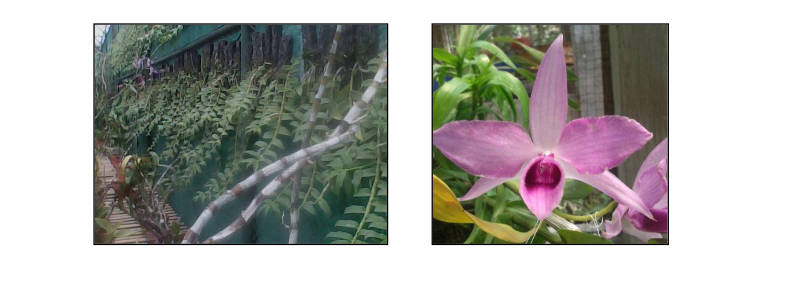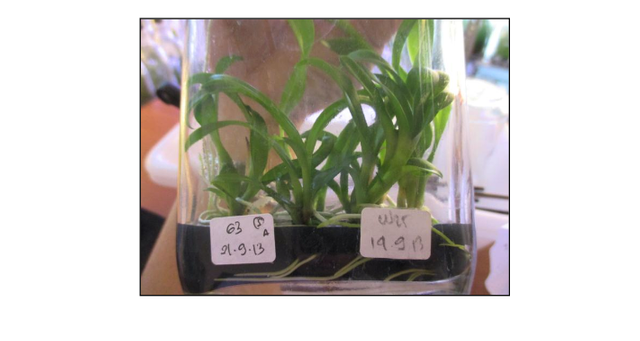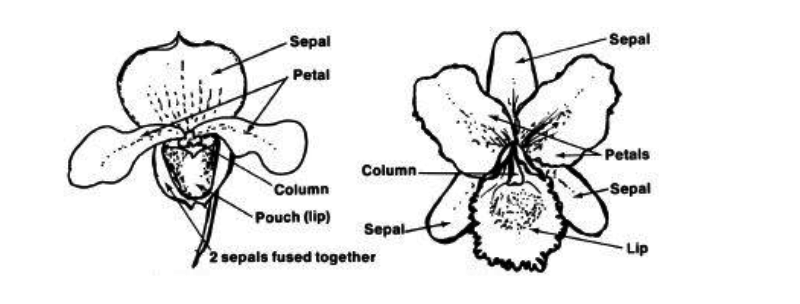Description of orchid flowers [Billingual]
Orchid is one of the seed plants of the family Orchidaceae a lot of interest because of the shape and color of interest so that it can be used as raw materials for industrial cut flowers, potted plants or garden ornaments. Orchid is an ornamental flower plant in the form of parasite which is beautiful flowers. Orchid has been known since 200 years ago and since last 50 years began to be cultivated widely in Indonesia. Good, healthy and superior orchid seeds have several characteristics, namely strong rod shape, rapid growth, lush leaves, bushy and beautiful flowers.
Based on the nature of life, orchid plants can be divided into three groups :
Epiphytic orchid is a type of orchid that rides on another tree / tree but does not damage / harming the boarding. The tool used to stick is the root, while the root whose function is to search for food is the root of air.
The semi-epiphytic orchid is a type of orchid attached to another non-destructive tree / plant, only its sticky roots also function like aerial roots to search for food to flourish.
Terrestrial or terrestrial orchid orchid is a type of orchid that lives on the ground.
The height of the place suitable for orchid cultivation can be divided into 3 kinds :
a. Hot orchids, the orchids that can grow at an altitude of 0-650 mdpl. Hot orchids require a temperature of 26-30 ° C at noon, 21 ° C at night. Examples of this orchid species are:
- Dendrobium phalaenopsis
- Onchidium papillo
- Phaphilopedillum bellatum
b. Orchids are, orchids that can grow at an altitude of 150-1500 masl. Orchids are generally grown at daytime temperatures of 21 ° C and 15-21 ° C, at night.
c. Cold orchids, the orchids that can grow at an altitude of more than 1500 mdpl. Cold orchids rarely grow in Indonesia, grow well at air temperature 15-21 ° C during the day and 9-15 ° C at night. Example: Cymbidium type orchid.
Types of orchids found in Indonesia include beautiful species, among others: Vanda tricolor in West Java and in Kaliurang, Vanda hookeriana, purple speckled from Sumatra, orchid / Dendrobium phalaenopis, Phalaenopsis amabilis orchid orchid Apple Blossom , Paphiopedilun praestans orchids from Irian Jaya and Paphiopedilun glaucophyllum orchids from Central Java.

The benefits of orchid plants
The main benefits of this plant is as an ornamental plant because the orchid has a beauty, the smell is typical. In addition, orchids are useful as a mixture of medicinal herbs, perfume / hair oil.
Orchid plants can be distinguished by the nature of his life, namely:
Orchid Ephytis is a type of orchid that sheds on the stem / tree but does not damage / harming the boarding. The tool used to stick is the root, while the root whose function is to search for food is the root of air.
Ephytis semi orchid is a type of orchid attached to trees / plants that are not damaging the other boarded, only the root of the sticky also functions like the roots of the air is to find food to grow.
Orchid soil / orchid Terrestris is a type of orchid that lives on the ground.

Morphologically, the orchid plant consists of several parts as follows :
Roots
Orchid roots are cylindrical, fleshy, soft and breakable. The tip of the root is tapered, slippery and slightly sticky. In a dry state, the roots appear to be white silvery and only the tip of the root is green or looks a bit purplish. The old roots will be dark brown and dry. The root of the filamentous orchid, the outer layer consisting of several layers of hollow and transparent cells, and is a protective layer in the root canal system.Trunk
According to Rudall et al. (2013) orchid stems are diverse, some are slender, full-bodied or fleshy thick in certain parts only, with or without pseudobulb. Based on its growth, the orchid stems can be divided into two types: simpodial and monopodial types.Leaf
The shape of orchid leaves consists of various shapes, there is an ovoid, ovoid inverted, meaning the upper part of the leaf width and the base of the base less wide, elongated like a ribbon or similar leaf sugar cane. Leaves of Coelogyne and Spathoglottis are close to the shape of turmeric leaves, while the leaves of the genus Dendrobium and Phalaenopsis are rounded elongated. The thickness of the leaves varies, from thin to fleshy and stiff, flat surface. The leaves are not stemmed, fully seated on the stems. The edges are not jagged with split leaf tips. Leaf bone is parallel to the leaf edge and ends at the end of the leaf. The arrangement of leaves alternates or confronts. The leaves of orchids are light green or dark green, yellowish and some are spotted (Tjitrosoepomo, 2013).Flowers
Orchids are arranged in bouquets. The number of flowers on one essay can consist of one to many buds. Wreaths on some species are located in the terminal, whereas in most of them are aksilar (Kuswandi, 2012). Orchid flowers have several main parts of sepal (petal leaf), petal (crown leaf), stamen (stamens), pistil (pistil) and ovary (going to fruit).
Sepal orchid amounted to three pieces. The upper sepals are called dorsal sepals, while the other two are called lateral sepals. The orchid has three petals, the first petals and the two are lined with sepals. The third petal undergoes modification to the labellum (lips).

5.Fruit and orchid seeds
According to Udomdee et al, the maturity of orchids is very dependent on the type of orchid itself. Dendrobium orchids will mature in 3 to 4 months, Vanda orchids after 6-7 months, while Cattleya orchids are ripe after 9 months. The orchid fruit is a fruit lantern and will break when it is ripe. Fruit picking is better done before the fruit ruptures but is nearing the maturity so that the seeds are ready to germinate.
Deskripsi Tentang Bunga Anggrek
Anggrek adalah salah satu tumbuhan berbiji dari famili Orchidaceae yang banyak diminati karena bentuk dan warna bunganya menarik sehingga dapat digunakan sebagai bahan baku industri bunga potong, tanaman pot atau hiasan taman. Anggrek merupakan tanaman bunga hias berupa benalu yang bunganya indah. Anggrek sudah dikenal sejak 200 tahun lalu dan sejak 50 tahun terakhir mulai dibudidayakan secara luas di Indonesia. Bibit anggrek yang baik, sehat dan unggul mempunyai beberapa ciri, yaitu: bentuk batang kuat, pertumbuhan pesat, daun subur, bunga lebat dan indah.
Berdasarkan sifat hidupnya, tanaman anggrek dapat dibedakan menjadi tiga kelompok yaitu :
Anggrek epifit adalah jenis anggrek yang menumpang pada batang/pohon lain tetapi tidak merusak/merugikan yang ditumpangi. Alat yang dipakai untuk menempel adalah akarnya, sedangkan akar yang fungsinya untuk mencari makanan adalah akar udara.
Anggrek semi epifit adalah jenis anggrek yang menempel pada pohon/tanaman lain yang tidak merusak yang ditumpangi, hanya akar lekatnya juga berfungsi seperti akar udara yaitu untuk mencari makanan untuk berkembang.
Anggrek tanah/anggrek terestrial adalah jenis anggrek yang hidup di atas tanah.
Ketinggian tempat yang cocok bagi budidaya tanaman anggrek dapat dibedakan menjadi 3 macam yaitu :
a. Anggrek panas, yaitu anggrek yang dapat tumbuh pada ketinggian 0-650 mdpl. Anggrek panas memerlukan suhu udara 26-30 °C pada siang hari, 21°C pada malam hari. Contoh jenis anggrek ini adalah:
- Dendrobium phalaenopsis
- Onchidium papillo
- Phaphilopedillum bellatum
b. Anggrek sedang, yaitu anggrek yang dapat tumbuh pada ketinggian 150-1500 mdpl. Anggrek sedang umumnya tumbuh pada suhu udara siang hari 21°C dan 15-21°C, pada malam hari.
c. Anggrek dingin, yaitu anggrek yang dapat tumbuh pada ketinggian lebih dari 1500 mdpl. Anggrek dingin jarang tumbuh di Indonesia, tumbuh baik pada suhu udara 15-21°C di siang hari dan 9-15°C pada malam hari. Contoh: anggrek jenis Cymbidium.
Jenis anggrek yang terdapat di Indonesia termasuk jenis yang indah antara lain: Vanda tricolor terdapat di Jawa Barat dan di Kaliurang, Vanda hookeriana, berwarna ungu berbintik-bintik berasal dari Sumatera, anggrek larat/ Dendrobium phalaenopis, anggrek bulan/Phalaenopsis amabilis, anggrek Apple Blossom, anggrek Paphiopedilun praestans yang berasal dari Irian Jaya serta anggrek Paphiopedilun glaucophyllum yang berasal dari Jawa Tengah.

Manfaat Tanaman Anggrek
Manfaat utama tanaman ini adalah sebagai tanaman hias karena bunga anggrek mempunyai keindahan, baunya yang khas. Selain itu anggrek bermanfaat sebagai campuran ramuan obat-obatan, bahan minyak wangi/minyak rambut.
Tanaman anggrek dapat dibedakan berdasarkan sifat hidupnya, yaitu :
Anggrek Ephytis adalah jenis anggrek yang menupang pada batang/pohon lain tetapi tidak merusak/merugikan yang ditumpangi. Alat yang dipakai untuk menempel adalah akarnya, sedangkan akar yang fungsinya untuk mencari makanan adalah akar udara.
Anggrek semi Ephytis adalah jenis anggrek yang menempel pada pohon/tanaman lain yang tidak merusak yang ditumpangi, hanya akar lekatnya juga berfungsi seperti akar udara yaitu untuk mencari makanan untuk berkembang.
Anggrek tanah/anggrek Terrestris adalah jenis anggrek yang hidup di atas tanah.

Secara morfologi, tanaman anggrek terdiri dari beberapa bagian sebagai berikut :
Akar
Akar anggrek berbentuk silendris, berdaging, lunak dan mudah patah. Bagian ujung akar meruncing, licin dan sedikit lengket. Dalam keadaan kering, akar tampak berwarna putih keperak-perakan dan hanya bagian ujung akar saja berwarna hijau atau tampak agak keunguan. Akar yang sudah tua akan berwarna cokelat tua dan kering. Akar anggrek berfilamen, yaitu lapisan luar yang terdiri dari beberapa lapis sel berongga dan transparan, serta merupakan lapisan pelindung pada sistem saluran akar.Batang
Menurut Rudall et al. (2013) batang anggrek beranekaragam, ada yang ramping, gemuk berdaging seluruhnya atau menebal di bagian tertentu saja, dengan atau tanpa umbi semu (pseudobulb). Berdasarkan pertumbuhannya, batang anggrek dapat dibagi menjadi dua tipe yaitu tipe simpodial dan tipe monopodial.Daun
Bentuk daun anggrek terdiri dari bermacam-macam bentuk, ada yang bulat telur, bulat telur terbalik, artinya bagian daun yang bagian atas lebar dan bagian pangkal kurang lebar, memanjang bagai pita atau serupa daun tebu. Daun jenis Coelogyne dan Spathoglottis mendekati bentuk daun kunyit, sedangkan daun genus Dendrobium dan Phalaenopsis berbentuk bulat memanjang. Tebal daun beragam, dari tipis sampai berdaging dan kaku, permukaannya rata. Daun tidak bertangkai, sepenuhnya duduk pada batang. Bagian tepi tidak bergerigi dengan ujung daun terbelah. Tulang daun sejajar dengan tepi daun dan berakhir di ujung daun. Susunan daun berseling-seling atau berhadapan. Daun anggrek berwarna hijau muda atau hijau tua, kekuningan dan ada pula yang bercak-bercak (Tjitrosoepomo, 2013).Bunga
Bunga anggrek tersusun dalam karangan bunga. Jumlah kuntum bunga pada satu karangan dapat terdiri dari satu sampai banyak kuntum. Karangan bunga pada beberapa spesies letaknya terminal, sedangkan pada sebagian besar letaknya aksilar (Kuswandi, 2012). Bunga anggrek memiliki beberapa bagian utama yaitu sepal (daun kelopak), petal (daun mahkota), stamen (benang sari), pistil (putik) dan ovarium (bakal buah).
Sepal anggrek berjumlah tiga buah. Sepal bagian atas disebut sepal dorsal, sedangkan dua lainnya disebut sepal lateral. Anggrek memiliki tiga buah petal, petal pertama dan kedua letaknya berseling dengan sepal. Petal ketiga mengalami modifikasi menjadi labellum (bibir).

5.Buah dan biji anggrek
Menurut Udomdee et al, kematangan buah anggrek sangat tergantung pada jenis anggrek itu sendiri. Buah anggrek Dendrobium akan matang dalam umur 3 sampai 4 bulan, buah anggrek Vanda setelah 6-7 bulan, sedangkan buah anggrek Cattleya baru matang setelah 9 bulan. Buah anggrek adalah buah lentera dan akan pecah ketika matang. Pengambilan buah lebih baik dilakukan sebelum buah pecah tetapi sudah mendekati masa matang sehingga biji siap untuk berkecambah.




